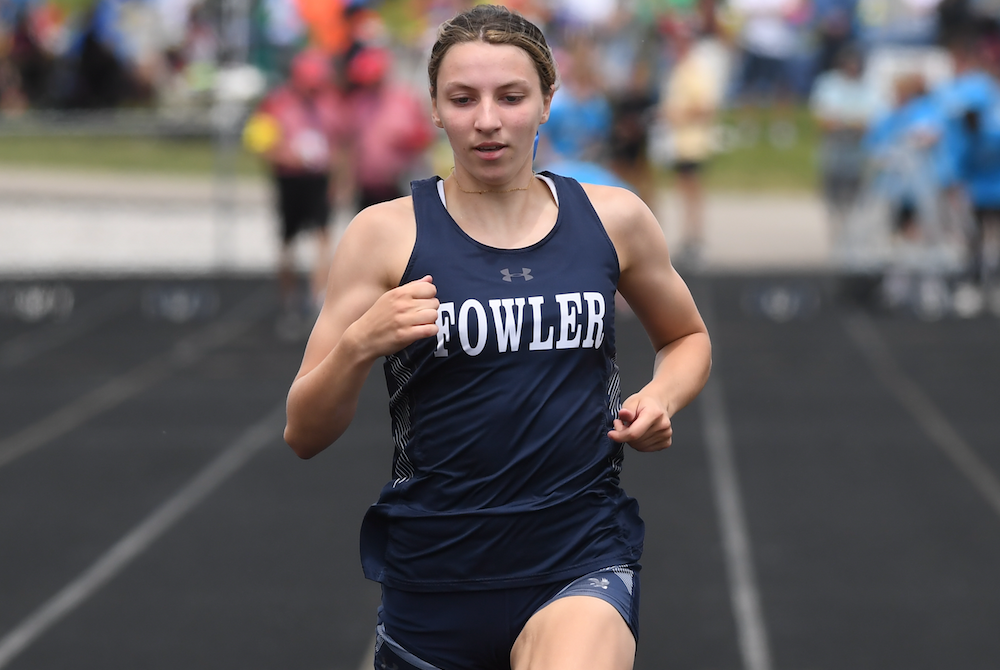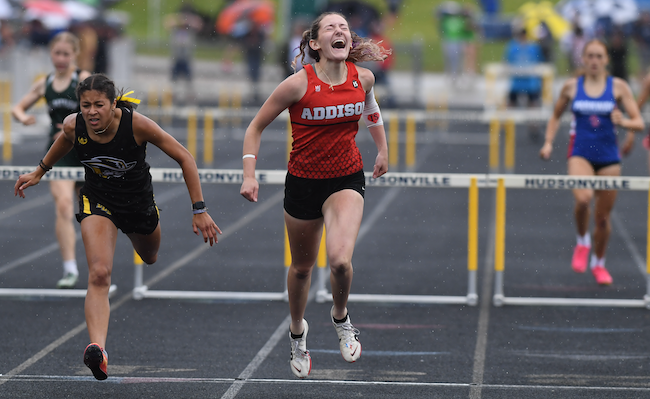
New Math: Division & Multiplication Problems
July 25, 2017
By Jack Roberts
MHSAA Executive Director
This is the second part in a series on MHSAA tournament classification, past and present, that will be published over the next two weeks. This series originally ran in this spring's edition of MHSAA benchmarks.
High school tournament classifications went viral before there was social media and most of us knew what “viral” meant.
Much as a virus infects computers today or has created epidemics of disease around the world for centuries, high school tournament classification – once introduced – tends to spread uncontrollably. Once started, it tends to keep expanding and rarely contracts.
While we are still some distance from providing every team a trophy as a result of expanding high school tournament classification across the country, there is criticism nevertheless that we are headed in that direction – a philosophy which is supposed to exist only in local youth sports for our youngest children.
Michigan could be blamed for all this. Michigan is generally accepted as the first state to provide different classifications for season-ending tournaments for different sized schools. It started a century ago. Today, every state has various classifications for its tournaments in most if not all sports. And it is a bit ironic that Michigan – creator of the classification chaos – more than most other states has kept the number of tournament classes or divisions under control.
Yes, there is evidence that tournament classifications have expanded over the years in Michigan, especially with the relatively recent introduction of tournaments in football and the late 1990s’ move from classes to divisions in most MHSAA tournaments. But the MHSAA Representative Council has held true to its word when it expanded the playoffs for football from four classes to eight divisions: this is needed because of unique factors of football, factors that exist in no other sport; and all other sports should be capped at a maximum of four classes or divisions.
Kentucky is the preeminent defender of single-class basketball. All of its 276 high schools compete for the single state championship for each gender. In Indiana, there are still open wounds from its move in 1998 from one to four classes for its 400 schools in basketball.
Multi-class tournaments have tended to increase the number of non-public school champions, which some states are trying to lower through enrollment “multipliers,” and also tend to increase the number of repeat champions, which some states are trying to affect with “success factors” which lift smaller schools into classifications for larger schools if they take home too many trophies.
While there is considerable evidence that state tournaments do as much bad as good for educational athletics, state associations persist in providing postseason tournaments because, on balance, the experiences are supposed to be good for student-athletes. And once we reach that conclusion it is just a small leap to believe that if the tournaments are good for a few, they must be better for more – which leads to creating more and more tournament classifications. One becomes two classes, then three, then four and so forth.
While the argument is that more classifications or divisions provides more students with opportunities to compete and win, it is undeniable that the experience changes as the number of tournament classifications expands. It is not possible for state associations to provide the same level of support when tournament classifications expand to multiple venues playing simultaneously. For example, there is less audio and video broadcast potential at each venue, and less media coverage to each venue. Focus is diluted and fans diminished at each championship.
No one can argue reasonably that today's two-day MHSAA Football Finals of eight championship games has the same pizazz as the one-day, four-games event conducted prior to 1990.
In some states the number of divisions has grown so much that it is difficult to see much difference between the many season-ending state championship games and a regular-season event in the same sport.
It is a balancing act. And Michigan has been studying that balance longer than any other state, and charting a steadier course than most.
Addition by Division
The shift to Divisions for MHSAA Tournament play in numerous sports has added up to a greater number of champions for teams and individuals across the state. Following are the sports currently employing a divisional format, and the procedures for determining enrollment and classification.
In 23 statewide or Lower Peninsula tournaments, schools which sponsor the sport are currently divided into nearly equal divisions. They are:
- Baseball - 4 Divisions
- Boys Bowling - 4 Divisions
- Girls Bowling - 4 Divisions
- Girls Competitive Cheer - 4 Divisions
- LP Boys Cross Country - 4 Divisions
- LP Girls Cross Country - 4 Divisions
- LP Boys Golf - 4 Divisions
- LP Girls Golf - 4 Divisions
- Ice Hockey - 3 Divisions
- Boys Lacrosse - 2 Divisions
- Girls Lacrosse - 2 Divisions
- Boys Skiing - 2 Divisions
- Girls Skiing - 2 Divisions
- LP Boys Soccer - 4 Divisions LP
- Girls Soccer - 4 Divisions
- Girls Softball - 4 Divisions
- LP Boys Swimming & Diving - 3 Divisions
- LP Girls Swimming & Diving - 3 Divisions
- LP Boys Tennis - 4 Divisions
- LP Girls Tennis - 4 Divisions
- LP Boys Track & Field - 4 Divisions
- LP Girls Track & Field - 4 Divisions
- Wrestling - 4 Divisions
Lists of schools for each division of these 23 tournaments are posted on MHSAA.com approximately April 1. Listings of schools in Upper Peninsula tournaments for their sports are also posted on MHSAA.com. The lists are based on school memberships and sports sponsorships in effect or anticipated for the following school year, as known to the MHSAA office as of a date in early March.
In football, the 256 schools which qualify for MHSAA 11-player playoffs are placed in eight equal divisions annually on Selection Sunday. Beginning in 2017, the 8-player divisions will be determined in a like manner on Selection Sunday as well, with 32 qualifying schools placed in two divisions.
Schools have the option to play in any higher division in one or more sports for a minimum of two years.
The deadlines for "opt-ups" are as follows:
- Applications for fall sports must be submitted by April 15
- Applications for winter sports must be submitted by Aug. 15
- Applications for spring sports must be submitted by Oct. 15
Subsequent to the date of these postings for these tournaments, no school will have its division raised or lowered by schools opening or closing, schools adding or dropping sports, schools exercising the option to play in a higher division, or approval or dissolution of cooperative programs.
When the same sport is conducted for boys and girls in the same season (e.g., track & field and cross country), the gender that has the most sponsoring schools controls the division breaks for both genders.

Fowler Girls Award 1st-Year Coach with Program's 1st Finals Title since 2019
By
Keith Dunlap
Special for MHSAA.com
June 2, 2024
HUDSONVILLE — Sometimes it actually isn’t so hard to replace a legend. Just ask Fowler girls track & field coach Neil Hufnagel.
After last year, Hufnagel took over for longtime Fowler coach Jill Feldpausch, who built the program into a dynasty.
Feldpausch led Fowler to five MHSAA Finals titles from 2011 to 2019, but there was no need for anyone to feel sorry for Hufnagel going into this year.
On the contrary, it might have been the track & field version of inheriting a Fort Knox-sized gold mine.
“She left the cupboards absolutely packed,” he said.
That was evident during the Lower Peninsula Division 4 Finals on Saturday at Baldwin Middle School, where Fowler reigned supreme again with a dominant performance.
Fowler finished with 70.5 points, well ahead of the 44 collected by runner-up Portland St. Patrick.
Fowler had only one first-place event finish, and that was in the last one, taking first in the 1,600 relay in a time of 4:08.44.
But that didn’t end up mattering as Fowler used its depth to score points.
The Eagles, who finished fourth last year, snapped a mini drought by their standards.
“We talked a little bit about being workmanlike,” Hufnagel said. “We know that it doesn’t take first places to finish first in the state. We had some good team depth, and we were able to use that.”
 Saugatuck was third with 34 points.
Saugatuck was third with 34 points.
There were several individual standouts who flanked Fowler’s team victory.
Buckley senior Aiden Harrand, who will run next for Wake Forest, won the 1,600 in a time of 4:53.25 and the 400 in a time of 58.25. Harrand also finished second in the 800.
Between cross country and track, Harrand finished her high school career with 10 Finals championships and showed impressive versatility.
“It’s hard for sure,” Harrand said. “I do a lot of distance training. I have to because I have to be prepared for that mile. I think the speed comes naturally. I do a lot of speed workouts and stuff. But you’ve got to train distance.”
Another individual standout was Addison junior Molly Brown. She repeated in the 100 hurdles in a time of 15.22, and then won the 300 hurdles in a time of 45.07.
Brown was second in the 300 hurdles last year, and she obviously was thrilled to build on that defeat and set up what should be a big senior year in 2025.
“I knew the girl that beat me last year graduated, but I knew that coming in this year, I was going to have to run a really good time to win,” Brown said. “I just really wanted to win.”
In the field events, Marlette senior Olivia Findlay shined the brightest, winning the long jump with a distance of 17-feet, 4½ inches and the high jump in 5 feet, 5 inches.
Other champions included Unionville-Sebewaing sophomore Layla Bolzman in the 100 and 200, Johannesburg-Lewiston junior Allie Nowak in the 800, Whitmore Lake freshman Kaylie Livingston in the 3,200, Chesterfield Austin Catholic senior Lyla Mullins in the shot put and discus and Mason County Eastern junior Payton Haynes in the pole vault. Frankfort (400), Portland St. Patrick (800) and Whitmore Lake (3,200) also won relays. Athens junior Aleyah Deller won the adaptive 100, 200 and shot put events.
PHOTOS (Top) Fowler's Katie Spicer crosses the finish line during a sprint Saturday. (Middle) Addison's Molly Brown, right, finishes her 100 hurdles championship win. (Click for more from Ken Swart/RunMichigan.com.)

